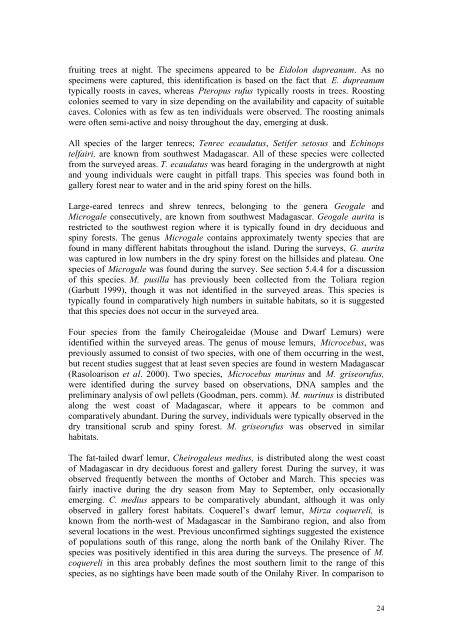The proposed Parc Regional de Belomotse - Frontier-publications ...
The proposed Parc Regional de Belomotse - Frontier-publications ...
The proposed Parc Regional de Belomotse - Frontier-publications ...
You also want an ePaper? Increase the reach of your titles
YUMPU automatically turns print PDFs into web optimized ePapers that Google loves.
fruiting trees at night. <strong>The</strong> specimens appeared to be Eidolon dupreanum. As no<br />
specimens were captured, this i<strong>de</strong>ntification is based on the fact that E. dupreanum<br />
typically roosts in caves, whereas Pteropus rufus typically roosts in trees. Roosting<br />
colonies seemed to vary in size <strong>de</strong>pending on the availability and capacity of suitable<br />
caves. Colonies with as few as ten individuals were observed. <strong>The</strong> roosting animals<br />
were often semi-active and noisy throughout the day, emerging at dusk.<br />
All species of the larger tenrecs; Tenrec ecaudatus, Setifer setosus and Echinops<br />
telfairi, are known from southwest Madagascar. All of these species were collected<br />
from the surveyed areas. T. ecaudatus was heard foraging in the un<strong>de</strong>rgrowth at night<br />
and young individuals were caught in pitfall traps. This species was found both in<br />
gallery forest near to water and in the arid spiny forest on the hills.<br />
Large-eared tenrecs and shrew tenrecs, belonging to the genera Geogale and<br />
Microgale consecutively, are known from southwest Madagascar. Geogale aurita is<br />
restricted to the southwest region where it is typically found in dry <strong>de</strong>ciduous and<br />
spiny forests. <strong>The</strong> genus Microgale contains approximately twenty species that are<br />
found in many different habitats throughout the island. During the surveys, G. aurita<br />
was captured in low numbers in the dry spiny forest on the hillsi<strong>de</strong>s and plateau. One<br />
species of Microgale was found during the survey. See section 5.4.4 for a discussion<br />
of this species. M. pusilla has previously been collected from the Toliara region<br />
(Garbutt 1999), though it was not i<strong>de</strong>ntified in the surveyed areas. This species is<br />
typically found in comparatively high numbers in suitable habitats, so it is suggested<br />
that this species does not occur in the surveyed area.<br />
Four species from the family Cheirogaleidae (Mouse and Dwarf Lemurs) were<br />
i<strong>de</strong>ntified within the surveyed areas. <strong>The</strong> genus of mouse lemurs, Microcebus, was<br />
previously assumed to consist of two species, with one of them occurring in the west,<br />
but recent studies suggest that at least seven species are found in western Madagascar<br />
(Rasoloarison et al. 2000). Two species, Microcebus murinus and M. griseorufus,<br />
were i<strong>de</strong>ntified during the survey based on observations, DNA samples and the<br />
preliminary analysis of owl pellets (Goodman, pers. comm). M. murinus is distributed<br />
along the west coast of Madagascar, where it appears to be common and<br />
comparatively abundant. During the survey, individuals were typically observed in the<br />
dry transitional scrub and spiny forest. M. griseorufus was observed in similar<br />
habitats.<br />
<strong>The</strong> fat-tailed dwarf lemur, Cheirogaleus medius, is distributed along the west coast<br />
of Madagascar in dry <strong>de</strong>ciduous forest and gallery forest. During the survey, it was<br />
observed frequently between the months of October and March. This species was<br />
fairly inactive during the dry season from May to September, only occasionally<br />
emerging. C. medius appears to be comparatively abundant, although it was only<br />
observed in gallery forest habitats. Coquerel’s dwarf lemur, Mirza coquereli, is<br />
known from the north-west of Madagascar in the Sambirano region, and also from<br />
several locations in the west. Previous unconfirmed sightings suggested the existence<br />
of populations south of this range, along the north bank of the Onilahy River. <strong>The</strong><br />
species was positively i<strong>de</strong>ntified in this area during the surveys. <strong>The</strong> presence of M.<br />
coquereli in this area probably <strong>de</strong>fines the most southern limit to the range of this<br />
species, as no sightings have been ma<strong>de</strong> south of the Onilahy River. In comparison to<br />
24
















